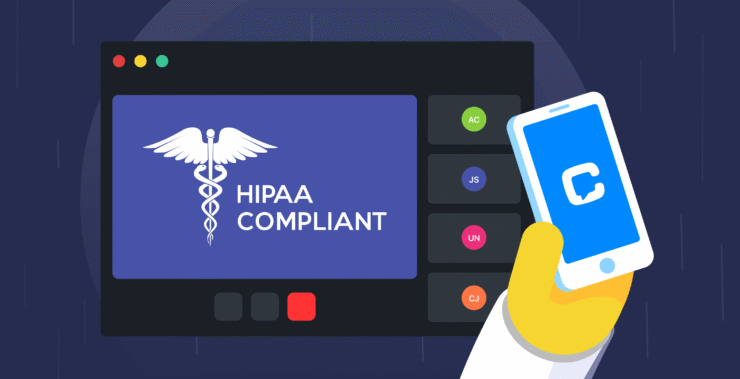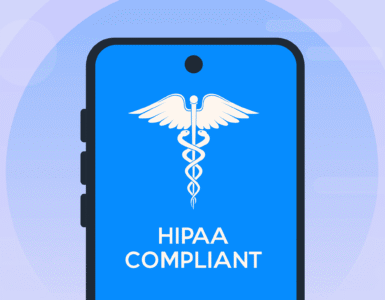As of 2025, nearly 80% of healthcare consumers have tried telemedicine at least once, and an astonishing 96% of telepsychiatry patients are happy with their virtual session.
These numbers tell us how online healthcare is trending, but they don’t place the whole picture into perspective. Telehealth is climbing incrementally, yet it’s not displacing in-person visits at all. Instead, it is a convenient solution for follow-ups, wellness coaching, and mental health treatment when an in-person sit-down isn’t an option.
For this to work on a large scale, practitioners, coaches, and patients need a safe place where they can connect up – a platform that has security requirements met. Having the right HIPAA telehealth platform is critical to having assurance that your patients’ information is safe, while you are free to focus on giving good care.
Whether running a solo practice or part of a small medical team, juggling video calls on one app and patient messages on another, with scheduling somewhere else, fast becomes a messy tangle that wastes time and energy. That is why many focus on using platforms designed to put it all together.
An example is Chanty, which unites rapid, safe messaging, voice and video calls, task assignment, and even international calling – all within a single easy-to-use space. It’s intended for clinicians who would rather dedicate time to care, whereas technology headaches are not on the agenda.
In this article, we will walk you through five of the most popular telehealth platforms, discuss what features really count, and introduce you to Chanty – created to ensure that your communication goes smoothly, securely, and in sync with your workflow, whether you’re working solo or collaboratively.
HIPAA-compliant telehealth platforms for 2025
- Chanty – Team chat and task management; ideal for internal clinic collaboration.
- Doxy.me – HIPAA-compliant video calls; no downloads needed for patients.
- Teladoc Health – Video visits, remote monitoring, and care coordination tools.
- SimplePractice – Practice management software with secure video sessions.
- Zoom for Healthcare – HIPAA-ready video conferencing for virtual care delivery.
- Klara – Secure patient messaging and workflow automation for medical teams.
What is a HIPAA telehealth platform?
Telemedicine first sought to offer general medical attention to rural and underprivileged populations, in which geographic or infrastructural limitations prevented immediate access to healthcare providers. The objective was simple: connect those patients who otherwise would have no care to the care they needed.
Telehealth has evolved a long way from that purpose today. Clients and patients can now choose from a wide “marketplace” of experts and pick the particular doctor or provider they want to work with, regardless of their location. Providing access to healthcare in rural communities remains an ongoing challenge, but individual convenience has quickly become the second-highest driving force behind telehealth adoption.
HIPAA telemedicine software is an encrypted computer system designed to make such a shift. It is not mere video conferencing since it encrypts confidential health information, controls who gets access to data, and logs in a very detailed fashion to meet HIPAA requirements. Providers implement Business Associate Agreements (BAAs) to maintain compliance and protect patient privacy.
These platforms offer safe teletherapy solutions that enable safe, private therapeutic communications between patients and providers. They facilitate telehealth team collaboration, such that small healthcare teams or solo doctors are more easily able to provide coordinated care from their offices.
In such a rapidly expanding telemedicine environment, a good decision on the HIPAA telehealth platform is essential to providing good quality care without compromising on privacy or convenience.
What professionals need: Needs and frustrations
When healthcare professionals choose a HIPAA telemedicine solution, they’re not choosing any video tool – they’re looking for one that streamlines their workflow, secures patient data, and simplifies communication. Here’s what matters most:
What matters most
- Ease of use for both patients and clinicians is non-negotiable. Products that take an eternity to figure out or have incomprehensible interfaces are more of a hindrance than a help. The last thing you want is a patient having difficulty logging in when you’re running behind schedule.
- Robust audio and video with minimal lag is critical. Interruptions and delay break the flow of therapeutic communication and can undermine trust. Telepsychiatry software and teletherapy platforms need to be capable of providing a seamless, unbroken experience that is virtually indistinguishable from a face-to-face session.
- Major positives are the combination of task and note management. Practitioners enjoy platforms that enable them to schedule appointments, maintain treatment notes, and monitor follow-ups – all in one place where communication occurs. It saves time and keeps valuable information safe and accessible.
- Cell phone access and the capability of making calls, both domestic and foreign, aid in broadening your scope. Whether your patient is local or international, a patient and provider telehealth app that accommodates flexible communication channels is a clincher.
- Finally, the ability to scale from independent practice to team collaboration without having to shift platforms is invaluable. Telehealth team collaboration features allow small groups to work together on care effectively, securely share information, and avoid fragmentation.
What drives providers crazy
- Too complicated platforms or switching between multiple disconnected apps is draining even the most tech-savvy practitioners. Fragmented workflows increase the potential for errors and reduce time on actual care.
- Data security threats are still a top priority. PHI leaks can lead to serious legal problems and undermine patient trust. Teletherapy tools need to be compliant, encrypted, and reliable.
- Crossing over between stand-alone video, messaging, and scheduling platforms not only slows down but also increases the probability of lost communication or forgotten meetings.
- Finally, most platforms are clunky to scale gracefully when practices grow. What is manageable as a single therapist can collapse when adding staff members or serving additional patients.
Best teletherapy platforms in 2025 [side-by-side review]
Choosing the right platform for remote care isn’t just about video quality or pricing – it’s about finding tools that truly support how you work. Whether you’re running a solo therapy practice or managing a care team, this breakdown helps you navigate the best secure teletherapy tools available today. From streamlined scheduling to built-in task management, see how these solutions stack up.
Chanty
Chanty
When it comes to choosing the best platform for therapists, Chanty stands out by combining simplicity, security, and seamless teamwork – all in one easy-to-use app. Whether you run a solo practice or coordinate a small healthcare team, Chanty supports therapeutic communication with secure messaging, audio and video calls, and smooth task management.
Unlike many telepsychiatry software options that focus solely on video, Chanty offers a complete solution that keeps everyone connected in real time. From instant messaging and file sharing to built-in Kanban boards, it’s designed to make team collaboration effortless – so you can spend less time juggling tools and more time focusing on patient care.
Chanty also offers a generous free plan that covers secure messaging and essential collaboration features, making it accessible for practitioners just starting out.
What sets Chanty apart?
- Fully HIPAA and GDPR compliant, with end-to-end encryption and strict access controls
- Intuitive design requiring no IT headaches – get started quickly regardless of tech experience
- Combines secure communication tools with task tracking and team collaboration in one place
- Flexible deployment options: cloud-based or on-premises
Whether you’re delivering virtual care or managing patient coordination, Chanty helps healthcare professionals stay connected and compliant without unnecessary complexity.
Ready to see how Chanty can simplify your practice?
Book a demo and experience a better way to communicate.
Doxy.me
Doxy.me
Doxy.me remains a go‑to platform for solo clinicians or small practices seeking a free, HIPAA‑compliant teletherapy solution. Its strength lies in simplicity – clients join via a browser link, no download required, and providers appreciate the consistent virtual waiting room experience.
Pros:
- No download needed – browser-based access
- Free HIPAA-compliant video calls
- Customizable virtual waiting room
- Simple and clean interface
Cons:
- Occasional video/audio lags with low bandwidth
- Limited customer support for free users
- Free plan lacks billing, screen sharing, and advanced tools
Pricing:
- Free plan available
- Professional – $35/month
- Clinic – $50+/month
Verdict:
Doxy.me is ideal for practitioners looking for a lean, no-fuss platform to conduct secure virtual sessions. However, those needing advanced workflows or HD streaming may find it too basic.
Teladoc Health

Teladoc
Teladoc Health offers a comprehensive telehealth platform that connects patients with licensed providers across specialties. Its solution includes video consultations, remote monitoring, and care coordination tools, making it ideal for hospitals, large clinics, and multi-provider networks. Teladoc supports secure, HIPAA-compliant communication while integrating with EHR systems to streamline workflows and patient follow-ups. Perfect for organizations seeking scalable, end-to-end telehealth solutions.
Pros:
- Video visits and remote monitoring tools
- Secure, HIPAA-compliant communication
- EHR integration for seamless workflows
- Scalable platform for multi-provider networks
Cons:
- May be more complex than simple telehealth apps
- Cost can be higher for smaller practices
Pricing:
- Custom pricing based on organization size and needs
Verdict:
Teladoc Health is a top choice for providers looking for a robust, scalable telehealth platform that goes beyond basic video calls, supporting comprehensive care coordination and secure patient engagement.
SimplePractice
SimplePractice
SimplePractice stands out for its clean design, user-friendly interface, and robust set of features. From client intake to billing and scheduling, everything is designed to streamline therapy practices.
Pros:
- Seamless video sessions
- Client portal with secure messaging
- Built-in scheduling, billing, and reminders
- Mobile app for both therapists and clients
Cons:
- Higher cost compared to basic tools
- Some useful features are locked behind higher-tier plans
- Can feel overwhelming at first
Pricing:
- Starter – $24.50/month (now $49 for three months)
- Essential – $39.50/month (now $79 for three months)
- Plus – $49.50/month (now $99 for three months)
Verdict:
SimplePractice is best for providers who want more than just video calls – it’s an all-encompassing platform that supports both client care and back-end practice management.
Zoom for Healthcare
Zoom for healthcare
Zoom for Healthcare brings the familiar Zoom interface to a HIPAA-compliant environment, tailored for telehealth professionals. It’s scalable, secure, and trusted by hospitals and solo providers alike.
Pros:
- HIPAA and HITRUST-certified
- Supports group sessions and screen sharing
- High-quality video and audio
- Compatible with multiple EHRs
Cons:
- More expensive than basic video tools
- Requires a BAA and special license for compliance
- Limited practice management features
Pricing:
- Pro: $159.99/month per user
- Business, Business Plus, Enterprise: Custom pricing only
- You need to select the paid plan and establish a BAA agreement
Verdict:
Zoom for Healthcare is ideal for organizations that need an enterprise-grade telehealth solution. It’s not the cheapest, but it’s a top-tier option for clinics already comfortable with Zoom.
Klara
Klara
Klara is a communication-first healthcare platform built for HIPAA-compliant texting, telehealth, and patient engagement. It focuses on reducing phone calls and no-shows by giving practices a modern way to connect with patients.
Pros:
- Secure texting and appointment reminders
- HIPAA-compliant video calls
- EHR integration and automation features
- Patient communication hub across channels
Cons:
- No built-in billing or documentation tools
- Interface takes time to master
- Video quality can vary
Pricing:
- Custom pricing – available upon request
- Typically subscription-based, per provider
Verdict:
Klara is best suited for practices that want to modernize patient communication while maintaining compliance. It shines in coordination and messaging – not full EHR features
Comparing the best HIPAA-compliant apps for teletherapy in 2025
| Platform | HIPAA-Compliant | Audio/Video Calls | Task Management / Kanban | Solo / Team Use | Key Feature or Advantage |
| Chanty | ✅ Yes | ✅ Audio, Video, Voice | ✅ Built-in with Kanban | Solo & Teams | Combines therapeutic communication with task tracking in one secure platform |
| Doxy.me | ✅ Yes | ✅ Video Only | ❌ No Task Features | Best for Solo Use | Popular free telehealth software, simple and accessible |
| Teladoc Health | ✅ Yes | ✅ Audio & Video | ❌ No Kanban | Solo → Large Teams | Scalable telehealth platform with video visits, remote monitoring, and care coordination |
| SimplePractice | ✅ Yes | ✅ Video (HD) | ✅ Scheduling & Docs | Solo → Small Practices | Full EHR, billing, and secure client portal |
| Zoom for Healthcare | ✅ Yes | ✅ HD Video & Audio | ❌ No Built-in Task System | Primarily Teams | Enterprise-level telemedicine with robust integrations |
| Klara | ✅ Yes | ✅ Messaging + Video | ❌ No Kanban | Teams | Designed for telehealth team collaboration, async messaging |
Final word: Telehealth isn’t just about convenience anymore
In today’s world, access to healthcare isn’t always guaranteed – but telehealth is bridging that gap. Roughly 10% of all outpatient visits nationwide now happen remotely, a dramatic increase from pre-pandemic levels, showing that virtual care has become a fundamental part of modern healthcare. It’s especially valuable in telepsychiatry, where even a brief, secure video call or message can provide the clarity, support, and reassurance patients need when it matters most.
Still, boundaries matter, and it’s important to assess situations with a clear head.HIPAA-compliant telehealth platforms are powerful tools, but they’re not built for emergencies or situations requiring a full clinical evaluation. If a call or message isn’t enough to paint the full picture – please, seek in-person care. Your health is worth the follow-up.
For everything else, smart and secure teletherapy tools can help providers deliver quality care efficiently and securely. Whether you’re a solo practitioner or part of a growing team, Chanty offers a complete solution for secure communication, task coordination, and team collaboration – all within a HIPAA-compliant environment. And thanks to international calling support, you can stay connected with clients around the globe, even when real-time video isn’t an option.
Try Chanty today and see how effortless secure healthcare collaboration can be.







